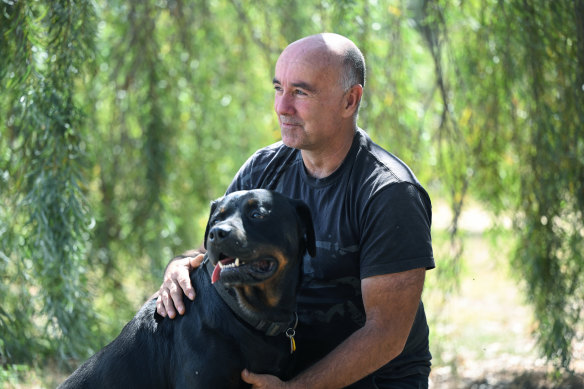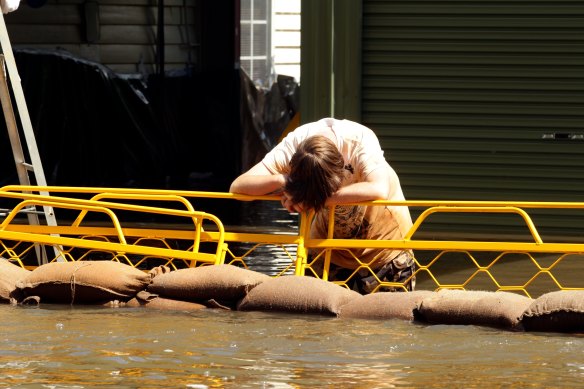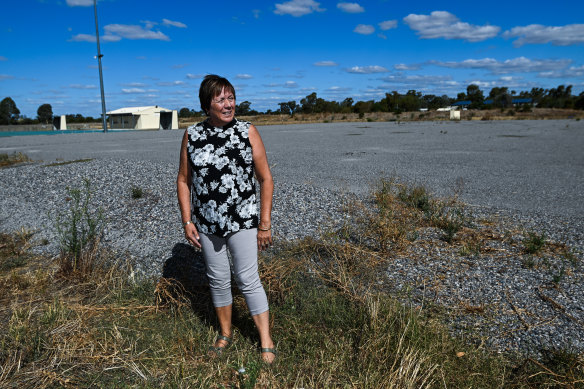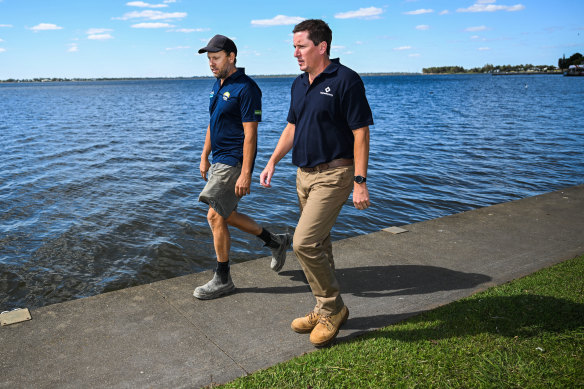
John Mangan does not regret taking on the Moira Shire, even though the ordeal has shattered his mental health.
He had coordinated waste and recycling at the north Victorian council for more than a decade when he began sounding the alarm with senior management about concerns of unsafe dumping of toxic waste, including asbestos-ridden soil.
John Mangan at his home in Yarrawonga.Credit:Joe Armao
His complaints went nowhere. Instead, he says, council managers pressured him to turn a blind eye to the illegal disposal of waste at municipal transfer stations.
Mangan maintains he was then subjected to a bullying campaign that included confected allegations of improper conduct, and was then suspended for daring to speak out.
Last year, he reached breaking point. He took his employer to the Federal Court, where the details of illegal waste dumping and bullying were made public as he sought to clear his name.
This week, in his fastidiously clean Yarrawonga home, Mangan struggled to contain rising waves of emotion while explaining how his fight with the Moira Shire upended his life.
“I have lost all my personal confidence and suffer from extreme anxiety,” he says. “I now find it near impossible to maintain my small farm and have put it up for sale.”
Mangan’s nightmare is among a litany of management failures and troubling practices uncovered by a wide-ranging commission of inquiry into the council.
In response, the state government announced it would sack all Moira Shire councillors after the commission’s 179-page report was tabled in Victorian Parliament on Tuesday.
Moira Shire has a population of about 30,000 people and takes in towns along the New South Wales border, including Yarrawonga and Cobram.
The commissioners, Frances O’Brien and John Tanner, made a raft of recommendations to improve governance in the municipality, including dismissing the council and appointing administrators for five years.
They urged the Victorian government to overhaul the council’s corporate, governance and performance division and adopt disciplinary processes in response to their report’s findings.
O’Brien and Tanner also made two referrals to Victoria’s anti-corruption commission: alleged corrupt conduct by the council’s coordinator of facilities maintenance and alleged dumping of asbestos by the council.
However, their investigation is also unequivocal in exonerating Mangan.
“Mr Mangan was suspended by the council for what the commission considers to have been wholly spurious reasons following his principled stand against council’s actions which he knew to be risky, wrong and dangerous,” the report says.
This week, Moira Shire had little to say about the commissioners’ recommendation that it should abandon its defence in Mangan’s case.
“We understand that it is a recommendation, and we’ll work through this with the administrator,” a spokesman said.
The spokesman then repeated the council’s denial of allegations it improperly disposed of waste, citing a response previously provided to The Age and insisting it followed all Environment Protection Authority regulations.
On Friday, the state government announced Tanner would be interim administrator for three months until a panel of administrators can be appointed.
Tanner and O’Brien’s report on the Moira Shire makes for alarming reading.
Among their most troubling conclusions is that the murder of senior council employee Rick Devlin, who was gunned down by colleague Andrew Paterson in August 2021, might have been prevented.
The inquiry found that the depot where Paterson worked in Nathalia had become an epicentre of bullying, harassment, threats and victimisation. The workplace was “fundamentally unsafe”.
“It was not the only depot or outdoors work site to suffer from these behaviours, but it was the setting in which the factors and events leading to Mr Devlin’s death played out without any constructive intervention by council administration,” the report says.
In November 2019, Paterson’s co-workers “set up” false allegations he stole kerosene from the depot, and he was stood down.
Paterson resented these unsubstantiated accusations and stopped going to work from November 2019. He began receiving payments through WorkCover in January 2020.
When Paterson requested a voluntary redundancy, the council rejected the request, even though similar arrangements were often approved.
Fifteen months later, Paterson shot Devlin with a revolver outside his Numurkah home. Paterson pleaded guilty to murder and was jailed for 26 years with a 21-year non-parole period last December.
A Supreme Court judgment found Paterson held an “unshakeable” belief that Devlin was behind his dismissal, even though Devlin was not Paterson’s direct manager.
This week Moira Shire chief executive Clare Keenan explained the murder occurred shortly after she took on the leadership role, insisting she quickly set about introducing measures to ensure staff were provided with “every possible support”.
The commissioners noted Keenan could not be held responsible for the shortcomings of previous administrations.
The commissioners wrote that “the failure of the council’s administration to ensure a safe and healthy environment in the depots and for the outdoors workforce has been compounded by the abject failure since the murder to put in place any plan or process to bring about the fundamental cultural and behavioural changes required”.
Before taking up the job at Moira Shire, Keenan had been chief executive at Burke Shire on the Gulf of Carpentaria, which has a population of about 550 people.
The commissioners regarded her as “ill-equipped with her limited experience” to deal with growing animosity between Moira councillors.
The report details how Keenan lashed out at a state government-appointed monitor put in place last year as concerns mounted about the council’s operations.
In one instance, the report says, Keenan wrote a late-night email to the monitor accusing her of being petty and biased.
“When questioned by the commission as to why she would write such an ill-judged email, she said that she was angry and needed to get it off her mind so that she could get to sleep.”
Keenan declined to answer further questions from The Age.
But mayor Peter Lawless maintained he was proud of the council’s achievements and argued it was heading in the right direction.
Members of the Moira Shire council pictured at the council’s offices in Cobram.Credit:Joe Armao
“I do not agree with all the findings of the commissioners and there are elements of the report that I don’t believe to be accurate,” he said in a statement released on Wednesday.
On Friday, he thanked council staff for their support. Lawless says staff who contacted him did not believe the report reflected their views of the workplace.
However, the inquiry determined that council inaction had left the community exposed to natural disaster in Numurkah, which suffered serious flooding in 2012.
The council had agreed to build a new levee to protect the town in 2018, but had taken little action since. “Had the recent flood event extended into Numurkah, wreaking devastation similar to 2012, council would have had much to answer for,” the commission’s report says.
The Australian Services Union, which helped bring the mismanagement at Moira Shire to light, still holds grave fears about the safety of employees.
Tash Wark, the ASU’s deputy branch secretary for Victoria and Tasmania, says those in senior management who acted improperly and contributed to Moira’s toxic workplace culture should stand down.
“Until there’s some change of who’s on the ground making decisions, we remain concerned,” she says. “The union is not assured of the workplace being safe for some time yet.”
The union’s misgivings had escalated dramatically in recent years and the commission noted that governance had been steadily eroding for the past decade.
A boy takes a break from sandbagging in Numurkah during the March 2012 floods. The recent inquiry concluded that council inaction had left the community exposed to a repeat of the flooding.Credit:Angela Wylie
Wark praised workers who came forward, pushed back against bullying and voiced their concerns about unsafe work practices.
“We have had reports of members being suicidal. We’ve got numerous members who have experienced depression, anxiety and stress.”
Meanwhile, many community members say they have long felt let down by the Moira Shire.
The commission noted it was provided with numerous examples across the shire of residents believing the council failed to respond in a timely manner, and sometimes not at all, to their concerns.
The commissioners are scathing of the council’s mismanagement of plans to build a much-needed indoor sport stadium in Yarrawonga that had already attracted more than $5 million in state and federal funding.
In a devastating blow to the community, the report says the stadium is unlikely to proceed in its proposed form. A cloud also hangs over a proposed library in Yarrawonga.
“The stadium project was described to the commission by a senior executive as a white elephant,” the report says. “The costs of both projects have increased substantially beyond their original cost estimates. Serious design deficiencies have also been identified in both projects.”
A sign directing stadium traffic stands before an empty block selected for the project. The site is covered by gravel and weeds.
Susan Bigger has been fighting for a stadium at Yarrawonga for 30 years. She says basketball is immensely popular in the riverside town, where about 300 juniors are playing the sport.
Susan Bigger at the site where the multi-sport stadium was to be built in Yarrawonga.Credit:Joe Armao
“We just can’t fit them in,” she says.
Now Bigger fears the council may have blown the community’s chance of finally getting its much-anticipated venue.
“I’m disgusted. We’ve been working on this for so long,” she says. “If we lose this funding it’s going to put us back years.”
Yarrawonga resident Johnny Leary says he grew up playing basketball on a “ratty” single-court hall at a local school. His children play on the same ageing court today. He says the council has long neglected Yarrawonga.
Strolling along the grassy banks of Lake Mulwala on the Murray River, Leary sees vast swathes of unrealised potential.
Johnny Leary (left) and Nick Dykes walk along the banks of Lake Mulwala in Yarrawonga.Credit:Joe Armao
“We should have restaurants and cafes along that lake, but we’ve got nothing,” he says.
Leary is part of a group campaigning for a “Yexit”, where Yarrawonga would separate from Moira Shire and form its own council.
He hopes the controversy surrounding Moira Shire will aid their cause: “It’s a long shot. But maybe the door’s ajar now.”
Not far away, John Mangan still worries about the safety of his colleagues who continue working at the shire. Sacking the councillors, he says, is not enough. He wants any managers involved in wrongdoing to be held accountable.
“The guilty people need to be dismissed, and appropriate legal action should follow to ensure this never happens again,” he says.
Then perhaps he will be able to move on, comforted by the knowledge that his colleagues will be safe from the horrific ordeal that still torments him.
Most Viewed in Politics
From our partners
Source: Read Full Article




